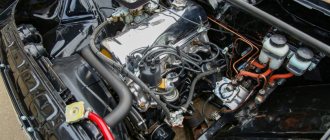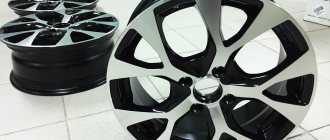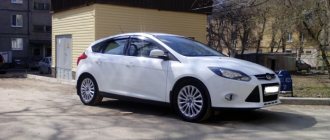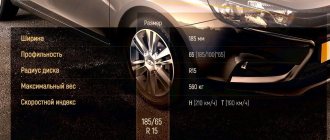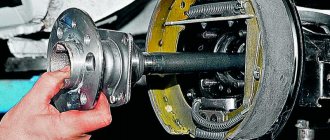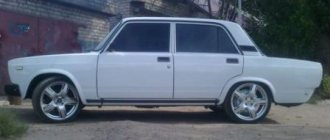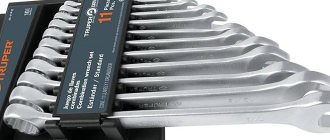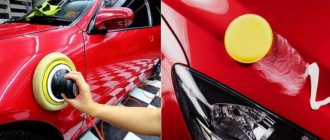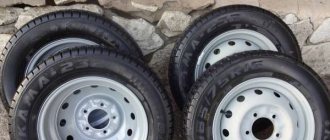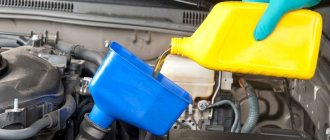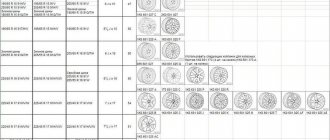Many owners are thinking about replacing standard Moskvich-2141 wheels with models from other cars or completely new ones. And the reason here is not only the desire to tune your car, but also the difficulties in finding “original” parts. And in markets and stores today they offer a wide range of products, both new and used, both steel and light alloy. But you need to figure out what kind of wheels can be installed on the Moskvich-2141 so that there is no harm to traffic safety.
The manufacturer gave the following recommendations regarding wheels for Moskvich-2141 . Tire sizes are 165/80 R14, 175/70R14, 185/70R14 and 185/65R14. In this case, steel wheels must have a 5J rim with an ET offset of 45 mm. A 5.5J rim with a 42mm offset is also allowed. Alloy wheels for Moskvich-2141 must have a 5.5J rim and an offset of 37 mm or a 6J rim and an offset of 33 mm. Note that the plant also allows the installation of tires 175/65 R15, as well as 185/65R15. In this case, the wheels must be 5.5J or 6J, and the offset must be 42 mm. It is worth paying attention to one nuance. If wheels are installed on a Moskvich-2141 with a profile width of 185 mm, such a wheel may not be mounted in the “original” fastener for the “spare tire” or in the niche for it.
In addition to the parameters described above, when selecting wheels for Moskvich-2141, mounting holes are also a decisive factor. This machine has 4 mounting holes with a circumference of 108 mm. In addition, it is important that the diameter of the central hole of the wheel rim is about 1-2 mm larger than the diameter of the hub. For the AZLK-2141 car, the latter is 52 mm.
If we talk about the selection of wheels for Moskvich-2141 from foreign cars, then here you can make a whole list of models. It will include Alfa Romeo 75 7th generation, Audi 80, 90, 100 until 1991, Ford Escort, Taunus, Cortina, Scorpio after 1995, Mondeo 1996-2000, Focus 1st generation, Cougar, Fiesta 3, 5 generations, as well as 4 generations until September 2008. In addition, wheels from many models of Peugeot and Citroen, SAAB 9000 1988-1992, Kia Alegro, Porsche 924 are suitable. Naturally, when selecting wheels for Moskvich-2141 , you may encounter the problem of discrepancy between the diameters of bolt or hub holes. The first ones can be drilled out if necessary. If they are more than required, then it is better to refuse such a purchase. In the case of hub holes, if it is larger on the disk than the diameter of the hub, then this is not critical. If it is less, then in this case it is also better not to purchase such disks.
Note that many tuning enthusiasts install wheels on Moskvich-2141 with a larger diameter and with different characteristics than those recommended by the factory. The main problem in this case is that the edge of the rubber does not reach the spring cup of the shock absorber strut of the front wheels, which is the element closest to the wheel. In such cases, replacing the rack with a unit from Moskvich Ivan Kalita can help. There are cone springs and a cup of reduced diameter. You can also upgrade the standard racks. Instead of the cut-off “original” cup, a part from the rear shock absorber of the VAZ-2109 is welded. Springs are selected according to the size and stiffness of the foreign car. But still, it is better to limit the scope of wheel selection to the framework established by the manufacturer.
Finally, we note that when choosing wheels for Moskvich-2141, it is not recommended to experiment with offset. As it increases, the load on the hub bearings increases several times. In addition, the retracement arm changes. This can provoke completely unpredictable changes in the car's handling. Therefore, the disc offset characteristics for Moskvich-2141 should be close to the values specified by the factory.
To install without spacers, the offset should be 35...38, maybe it will be useful for someone. Bolt pattern 5*114.3
Chrysler Cherokee 5 x 114.3 71.5 Chrysler Le Baron Cabrio/Coupe 5 x 114.3 35 71.5 Chrysler New Yorker 5 x 114.3 35 71.5 Chrysler Saratoga 5 x 114.3 71.5 Chrysler Vision 5 x 114.3 35 71.5 Chrysler Voyager 5 x 114.3 35 71.5 Chrysler Wrangler 5 x 114.3 71.5 Daewoo Leganza 5 x 114.3 35…42 56.5 Daihatsu Terios 5 x 114.3 30…40 66.6 Dodge Avenger (after 1995) 5 x 114.3 38…45 67.0 Dodge Stealth (after 1991) 5 x 114.3 38…45 67 .0 Ford Probe (before 1992) 5 x 114.3 35...38 59.5 Ford Probe (after 1992) 5 x 114.3 35...38 67.0 Honda Integra Type-R 5 x 114.3 45...50 64.0 Honda NSX 5 x 114.3 70/64 Honda Legend (after 1994) 5 x 114.3 35...38 70.0 Honda Odysee 5 x 114.3 35...38 64.0 Honda CRV 5 x 114.3 40...45 64.0 Honda Shuttle 5 x 114.3 35...38 64.0 Jeep Cherokee 5 x 114.3 35 71.5 J eep Grand Cherokee 5 x 114.3 35 71.5 Lexus GS300 5 x 114.3 35…42 60.0 Lexus SC300 5 x 114.3 35…42 60.0 Lexus LS400 5 x 114.3 35…42 60.0 Lexus SC400 5 x 114.3 35…42 60 .0 Mazda 323 2.0 V6 (after 1994 .) 5 x 114.3 35…42 67.0 Mazda 626 (before 1992) 5 x 114.3 35…42 59.5 Mazda 626 (after 1992) 5 x 114.3 35…42 67.0 Mazda 929 5 x 114.3 35…42 67.0 Mazda RX7 5 x 114.3 35…42 59.5 Mazda Xedos 6 5 x 114.3 35…42 67.0 Mazda Xedos 9 5 x 114.3 35…42 67.0 Mitsubishi 3000 GT 5 x 114.3 67.0 Mitsubishi Eclipse 5 x 114.3 35…42 67 .0 Mitsubishi Sigma 5 x 114.3 35… 42 67.0 Mitsubishi Space Gear 5 x 114.3 67.0 Nissan 200SX (after 1994) 5 x 114.3 35…42 66.0 Nissan 300ZX 5 x 114.3 35…42 66.0 Nissan Cedric 5 x 114.3 35…42 66.0 Nissan Gloria 5 x 114.3 35…42 66.0 Nissan Maxima 5 x 114.3 35...42 66.0 Nissan Serena 5 x 114.3 35...42 66.0 Nissan Skyline 5 x 114.3 35...42 66.0 Subaru Streega 5 x 114.3 56.0 Subaru SVX 5 x 114.3 56.0 Toyota MR2 (after 199 1 year) 5 x 114.3 35…38 60.0 Toyota Picnic 5 x 114.3 35…38 60.0 Toyota Previa 5 x 114.3 35…38 60.0 Toyota RAV4 5 x 114.3 35…38 60.0 Toyota Supra (after 1992) 5 x 114.3 35…38 60.0 Toyota Camry ( after 1991) 5 x 114.3 35…38 60.0 Toyota Hi-Ace 5 x 114.3 18…20 67.0 Land Rover Freelander 5 x 114 35 Volkswagen Taro 5 x 114.3 67.0
How to find out the bolt pattern of a VAZ wheel yourself
If there is no information about the bolt pattern, then you can independently find out the parameters of the required indicator in several ways:
- you can compare the purchased disk with the existing copy that you plan to replace;
- Visually determine the number of mounting bolts, and measure the distance between the holes with a caliper. Then, to the result obtained, we add the size of the diameter of the hole into which the bolt is screwed, and we obtain the distance between the centers of adjacent holes (we denote the resulting addition result as Y).
We calculate PCD ourselves. Next, we follow the formula, taking into account each bolt pattern:
- for 3 holes the diameter is Y*1.55;
- for 4 holes the diameter is Y*1.414;
- for 5 holes the diameter is Y*1.701.
Wheel size for AZLK 2141 Svyatogor
You need to move the wheels outward at least 10-12mm to avoid all problems. For the spacers I used 4mm thick aluminum sheets. There were three spacers for each wheel. The new wheel hub holes are too small to fit onto the front suspension hubs. I had to expand them in diameter by approximately 7-8mm with a grinder - to the required 75mm. After all these alterations, you can drive on new wheels, in my opinion, quite safely. By the way, in the photo in the front I have wheels from a Toyota Picnic, and in the back from a Mazda 626. They are very similar in appearance, but slightly different (the first have 14 slots in the disk, the second have 15). This is by the way.
I used the common tire size 185/65R14. At the same time, the rolling diameter increased by approximately 4% compared to 175/70R13 tires; accordingly, the vehicle speed at a given engine speed increased by the same amount, and accordingly, the acceleration dynamics in a given gear worsened. Subjectively, the ride quality and directional stability have improved significantly. I did not control fuel consumption, but other things being equal (speed, tire pressure, temperature, tread pattern, etc.) it can increase slightly due to an increase in tread width. In my opinion, there are no other factors influencing consumption with new wheels. For suggestions and criticism, please write to
Tires and wheels in Tyumen
There are cone springs and a cup of reduced diameter. You can also upgrade the standard racks. Instead of the cut-off “original” cup, a part from the rear shock absorber of the VAZ-2109 is welded. Springs are selected according to the size and stiffness of the foreign car. But still, it is better to limit the scope of wheel selection to the framework established by the manufacturer.
Finally, we note that when choosing wheels for Moskvich-2141, it is not recommended to experiment with offset. As it increases, the load on the hub bearings increases several times. In addition, the retracement arm changes. This can provoke completely unpredictable changes in the car's handling. Therefore, the disc offset characteristics for Moskvich-2141 should be close to the values specified by the factory.
Site search
In my opinion, a huge amount of material has already been written about the installation of various kinds of non-original wheels on Moskvich 412 series. However, there are often still rather contradictory information regarding which wheels can be adapted for installation on a Moskvich, and for which it is inappropriate to do this... It must be remembered that installing non-original (non-certified for it) wheels on a car is illegal, and , to be fair, really unsafe. Therefore, if you are really itching (like me, for example) to install other wheels, you need to at least approach such tuning responsibly. I had three reasons for installing non-original wheels: 1. Potentially better characteristics of larger wheels (both in width and diameter) in terms of smoothness and directional stability. 2. Larger wheel diameter, which affects the speed characteristics of the car. 3. Appearance. The last two motives are purely subjective and personally important to me. The choice initially settled on 14-inch wheels. I initially did not seriously consider the options for 15-inch wheels, because I think that this is too large a size for use on a Moskvich. So, as you know, standard wheels have the following parameters: landing diameter - 13 inches rim flange width - 5 inches rim shape code - J number of studs x diameter on which they are located - 5 x 115mm offset - 30mm hole diameter for the hub - 74mm Task Thus, the task was to find the wheels that were closest in parameters, differing only in the landing diameter - 14 inches. Options for wheels of Mercedes and BMW cars (including \'\'15\'\') are no longer necessary, since they have a stud diameter of 112 and 120 mm, respectively (at least for the common models known to me). You cannot install such wheels on Moskvich. A variant of wheels from Mazda 626, Xedox 6, Toyota HiAce, Toyota Picnic, etc. has appeared. One of the variants of wheel rims used on these cars has the following parameters: bore diameter - 14 inches, rim flange width - 6 inches, rim shape code - J number studs x diameter on which they are located - 5 x 114.3mm offset - 38mm hub hole diameter - 67mm There are both stamped steel and alloy wheels. In addition, they are common enough that they can be easily found for sale. The diameter of the studs is close enough to the original one (the offset of the studs relative to the holes is 0.35mm) so that the difference can be ignored
However, when tightening the nuts, you need to pay attention to the alignment of the wheel. It turned out that the offset of the new wheels was too large, so that the front wheels hit the inside of the upper control arm, and the rear wheels hit the inside of the wheel arch during turns and when the car rolls
Therefore, it turned out to be necessary to order new studs extended by 15 mm (all 20 pieces), and to make spacers for the wheels that increase the track.
Modifications
- Moskvich-427IE on the M-412IE platform - from the outside it was almost no different from the one produced at the same time and differing only in the M-426IE engine on the platform of the later M-408IE;
- Moskvich-408 – represents a standard sedan car;
- Moskvich-408E was an export version with a two-headlight radiator lining. The modification also met European safety standards;
- Moskvich-408I was an export variation of the sedan, which had a four-headlight radiator trim. Also met European safety standards;
- Moskvich-408IE - was an export version of the sedan, also complied with European safety standards;
- Moskvich-408P - represents an export variation of the sedan, which had a right-hand steering wheel. The model met European safety standards;
- Moskvich-408Yu - an export variation of the sedan for countries with a hot climate;
- Moskvich-408K was an export vehicle kit for large-scale production of a car;
- Moskvich-408M - a vehicle for medical services;
- Moskvich-408T - served in a taxi fleet;
- Moskvich-408B - the modification had manual controls (for the disabled);
- Moskvich-408U is a training variation of the sedan, where additional pedals and a steering wheel were installed.
Moskvich Ivan Kalita, Duet coupe
Probably the strangest model of the late 90s is the Duet coupe, which is a two-seater version of the Kalita. A budget option was also created based on the “Prince Vladimir” model. Of course, there was no demand for this “miracle”. Probably the strangest model of the late 90s is the Duet coupe, which is a two-seater version of the Kalita. A budget option was also created based on the “Prince Vladimir” model. Of course, there was no demand for this “miracle”.
In February 1996, the conveyor was stopped. The following year, the “forty-one” was modernized - the design of the front end changed. The updated car received the name “Svyatogor”. Some of the cars were equipped with a two-liter 113-horsepower Renault F3R engine, familiar from the Renault Laguna. In addition to the engine, Svyatogor acquired an imported clutch and brake booster. But again external factors intervened. The 1998 default hit the plant hard: the purchase of imported components led to huge losses. The agony of the 41st continued.
And even in these conditions, the plant could have a future. Indeed, in the second half of the nineties, Moskvich received the support of the Moscow government. But the plant management failed to properly manage the funds received. Instead of bringing the quality of the 41st to the required level, all efforts were thrown into the appearance of a whole army of “freaks”: “Yuri Dolgoruky”, “Prince Vladimir” and the tacky “Ivan Kalita”, which cost fabulous money. And also a modification of the Duet with a coupe body. But there was no demand. Even from the Moscow government.
The result is logical - production has been steadily declining and by 2001 it had dropped to 800 cars per year. On March 4, 2002, the conveyor was stopped and the power supply to the plant was cut off. No more cars under the Moskvich brand came off the Moscow assembly line. It's a shame, because initially the 41st Moskvich was a very good car. He aimed at an empty niche between the Volga and Samara. It was necessary to establish work with suppliers, improving quality, and bring new engine production to fruition. However, history decreed otherwise, and today Dusters and Captures are assembled on the territory of the former Moskvich. And Moskvich himself joined the list of brands that have sunk into oblivion.
Moskvich-2141: Moscow Simka
Compatibility of the Moskvich -408, -412 car with other domestic cars.
Compatibility of the Moskvich -408, -412 car with other domestic cars.
Installation of alloy wheels.
For Moskvich cars, alloy wheels can be selected without any problems. In this case, certain conditions must be observed. “Muscovites” are ideally suited for wheels with mounting holes located on a circle with a diameter of 115 mm (P C D) and an offset of 30 mm (ET). However, popular modern cars are not equipped with wheels of this size. The closest to these indicators are common disks with P C D equal to 114.3 mm. Japanese and Korean cars are equipped with such wheels, for example, some Mazda, Mitsubishi, Hyundai models. The existing difference of 0.7 mm in the diameter of the circle where the fastening bolts are located can be neglected, since each hole is shifted relative to the center by 0.35 mm, which is compensated by the conical fit of the fastening nuts. ET of 30 mm is advisable to comply with. Or, at least, choose wheels with an ET value of less than 30 mm. If the wheel offset is greater - for example, 35 mm, it turns out to be recessed 5 mm into the “depth” of the arches, which, along with the use of disks on wide tires, will lead to an unacceptably small gap between the rear wheel and the spring. Wheels with wide tires can also lead to a lack of “normal” clearance between the wheel and the fender. This problem can be solved either by changing the height and shape of the wing, or by installing stiffer springs to increase the distance from the wheel to the edge of the wing (not desirable). Or selecting a disk with a width of no more than 5.5 inches. But it is difficult to find such a disc, since today only heavy and powerful cars are equipped with five-pin hubs, which are not equipped with narrow wheels. When purchasing and installing “castings” on “Muscovites”, you should take into account that such disks, as a rule, have a large thickness in the mounting plane, so the length of the standard studs may not be enough and you will have to order extended ones from turners. You can buy a set of studs with nuts from Niva. They are longer and fit the Moskvich hub saddles. However, you should first check whether they are long enough for the drive you choose. In these cases, the operation of fastening the disk should be treated more responsibly, strictly observing the sequence of tightening the nuts according to the “star” pattern. Discs with cylindrical rather than tapered holes may work without stud extensions because their special extended nuts allow them to "grab" the threads deep into the disc. However, their use in this case is undesirable - problems with wheel alignment may arise. Finally, you need to pay attention to the diameter of the hole for the hub in the disk - parameter DIA. For “native” Moskvich wheels it is 74 mm, and for many alloy wheels it is less. As a last resort, in order to seat the disc on the thickened part of the hub, you can chamfer the inside of the hole on the mating plane of the disc or bore the central hole on a machine. After following the above operations, light alloy wheels will look like family wheels on a Muscovite. The choice of wheel diameter and tire type is now up to you.
Photo_1; Photo_2; Photo_3; Photo_4; Photo_5; Photo_6; Photo_7;
"New" sensations. Replacing steering rods.
The steering of Moskvich vehicles is distinguished by the short service life of the tie rod ends. You can make the structure more durable by replacing these components with others. Most often, the four joints of the steering linkage outer rods require replacement - sometimes they do not last even 10 thousand km. These parts can be replaced with analogues from the VAZ “classic”, which last much longer. In addition, the quality of spare parts for Zhiguli cars today is higher than for Moskvich cars, which have already been discontinued. “Zhiguli” and “Muscovites” belong to the same “weight” category (the curb/gross weight of the VAZ-2106/Izh-412IE is the same - 1045/1445 kg), the designs of the front suspension and steering linkage and the weight distribution along the axes of both cars are also very similar. Therefore, the loads on the steering control elements of the vehicles are approximately the same, which gives every reason to consider such a modernization to be legitimate from a technical point of view. The geometric parameters of the ball pins (cone dimensions and pin length) on Moskvich and Zhiguli are the same, so the levers do not need significant modifications. The only thing you have to do before installing the implanted parts is to order the turner a pair of new adjusting threaded bushings with locknuts according to the dimensions shown in the photo. The hole in the middle of the bushing is necessary to ensure the release of excess lubricant when screwing the tips into it. After assembly, through this hole, using a syringe, you can fill the inner cavity of the bushing with solid oil - to protect the threads from corrosion. Subsequently, when unscrewing the bushings through the hole, it will be possible to “lubricate” the rusted threads with kerosene or a product like WD-40. When mounting “Zhiguli” units on a car, you should remember that their “long” tips for the left and right sides of the car differ from each other (they have bends of different curvatures). If, when installing on a Moskvich, they are mixed up, when the wheels are turned to the maximum to the left, the steering bipod may rest against the steering rod. If installed correctly, this will not happen, which is easy to verify by first “assembling” the trapezoid without tightening the pin nuts. By the way, to dismantle them it is better to use special pullers: this will protect the rods and rubber boots from damage. At the end of the work, you need to make sure that all the nuts are well tightened and cottered, after which you need to adjust the angles of attack of the wheels. The Moskvich modernized in this way is noticeably easier to drive; its steering is devoid of typical play, which is especially noticeable when driving at high speed.
Any suggestions? Leave it in the guestbook or on the forum. Interesting stories and photographs will definitely be posted on our website!
Disc labeling
So, let's say you have a disk that displays the following information: 7.5 Jx16 H2 5/112 ET 35 d 58.5
. Let's look at each of the available notations.
7.5Jx16
, the first three, informs us that W - the rim width of this disk - is 7.5 inches (we must remember that almost all disk parameters are indicated in inches: 1 inch = 2.54 cm), D - diameter - is 16 inches, and also that this disk is not stamped/one-piece (“x” is the icon for cast and forged wheels).
Letter J
It’s also in this set for a reason. This letter indicates that the edges of the rim are intended for single-wheel drive cars, so if, for example, your car is all-wheel drive, the discs in question do not fit it and you need to look for identical ones, but with a different marking - JJ.
H2
carries information rather for specialists and informs them that the rim has 2 humps (ring protrusions) necessary to keep tubeless tires from slipping. Naturally, if there is only 1 such protrusion, it will be marked H1 on the marking. It is also possible that there will be a complete absence of such protrusions or their presence, but in a special design, when the symbols will be slightly different (AN, FH, CH). One way or another, for an ordinary motorist this parameter is practically unimportant, which cannot be said about the following numbers.
5/112
- this is a chatterbox. 5 is the number of landing bolts and holes for them, and 112 is the diameter of the circle on which these holes are located, and it is measured not in inches, but in millimeters familiar to a Russian person. There are three ways to find out the disc bolt pattern:
, however, more on this a little later, but for now let’s look at the remaining parameters.
Marking ET 35
indicates disc ejection. In this example, it is 35 mm; in principle, the offset is the distance between the axis of symmetry of the product and the plane of application of the disk to the hub. When the pressing plane is equal to the center of the disk, then the offset is called zero, when it protrudes beyond the limits, it is negative, and when, on the contrary, the center of the disk is closer to the hub than the plane of application of the disk, such an offset is called positive.
d 58.5
is the diameter of the central hole. When it does not coincide with the diameter of the seat cylinder on the car hub, then it is not at all necessary to look for new disks; you can simply buy an additional set of spacer rings, and then use them to adjust the said elements.
You can put p15 wheels on a Moskvich 412, what are the nuances?
It’s possible, but it’s a pain Alloy wheels for Moskvich 412 For rear-wheel drive Moskvich models, alloy wheels can be selected without any problems. In this case, it is necessary to comply with some conditions - “Muscovites” are ideally suited for disks in which the mounting holes are located on a circle with a diameter of 115 mm (PCD), and the offset is 30 mm (ET). However, popular modern cars are not equipped with wheels of this size. The closest to these indicators are common disks with a PCD of 114.3 mm. Japanese and Korean cars are equipped with such wheels, for example, some Mazda, Mitsubishi, Hyundai models. The existing difference of 0.7 mm in the diameter of the circle where the fastening bolts are located can be neglected, since each hole is shifted relative to the center by 0.35 mm, which is compensated by the conical fit of the fastening nuts. If the wheel offset is greater - for example, 35 mm, it turns out to be recessed 5 mm into the “depth” of the arches, due to which the low “Moskvich” cutouts (at the rear) do not interfere with the normal rotation of the wheels. It is not recommended to use wider tires, since in this case the gap between the rear wheel and the spring on one side, and the wing on the other, will be unacceptably small. However, finding wheels less than 5.5 inches wide will not be easy, since five-stud hubs today are only equipped with heavy and powerful cars, which are not equipped with narrow wheels. When purchasing and installing “castings” on “Moskvich” models 412 and 2140, you should take into account that such disks, as a rule, have a large thickness in the mounting plane, so the length of the standard studs may not be enough and you will have to order extended ones from turners. In this case, the operation of fastening the disk should be treated more responsibly, strictly observing the sequence of tightening the nuts according to the “star” pattern. Discs with cylindrical rather than tapered holes may work without stud extensions because their special extended nuts allow them to "grab" the threads deep into the disc. However, their use in this case is undesirable - problems with wheel alignment may arise. Finally, you need to pay attention to the diameter of the hole for the hub in the disk - the DIA parameter. For “native” Moskvich wheels it is 74 mm, and for many alloy wheels it is less. As a last resort, in order to seat the disc on the thickened part of the hub, you can chamfer the inside of the hole on the mating plane of the disc or bore the central hole on a machine.
